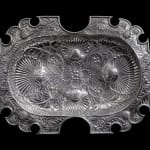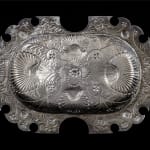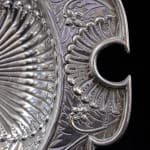“CHAROLA” PLATTER
Marks: male head over an M between crowned columns; eagle on a prickly pear and FVENTE; plus another mark: between crowned columns, a male head over a P (this initial is unclear). No zigzag assay gouge.
Marks of ownership engraved on the back: a symbol (some kind of poker, located in the middle) and the letters MLIR (or MILR) at the end of the shorter axis.
Weight: 1.799kg
Further images
Provenance
Private Collection.
This piece features an oval basin with mixtilinear profile, and a wide, flat outer border featuring twolarge, indented openings on the longer sides, the rest made up of straight edges alternating with concavegaps (numbering ten), symmetrically arranged throughout. There is also a prominent moulding alongthe edges. The shallow inner basin slopes gently down to the bottom from a moulded lip at the top. Theentire piece is covered by naturalistic decorative motifs, most prominent among which are undulating-sided scallop shells with radiating grooves. There are four big concave ones arranged around the sidesof the basin, and another four smaller ones making up a sort of quatrefoil on the very bottom. Furtherdecorative motifs include winding plant stalks with little four-petalled flowers and enormous flat leavesdistributed across the entire surface, both the basin and the flat outer border. The decoration has beenexecuted using delicate repoussé work and, to highlight the motifs, the free surfaces feature “picado delustre” punchwork.
Pieces matching the design of this work have been categorised with a range of names aimed at describingtheir possible functions. As such, what in English would be commonly called a serving “tray”, “basin”,“dish” or “platter” have been called “azafates”, “charolas”, “fuentes”, “bandejas”, “bacías”, “sangradores”and even “palanganas”, but on this occasion we think the most suitable term would be “charola”1(orpossibly “azafate”), not just because that is how they are called in Mexico (where this one is from, aswe shall be seeing shortly), but because its abundant Baroque decoration and the shallowness of thebasin are a fairly clear indication that is was not used as a barber’s basin (bacía), bloodletting bowl(sangrador), or wash bowl (palangana), but as a serving tray for a wide range of products. These pieceswere very popular household goods among the wealthy classes in the Baroque period.









